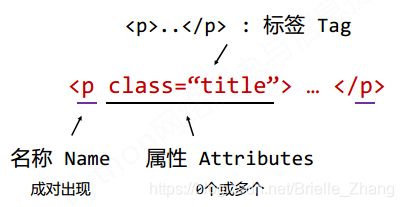【Python网络爬虫笔记】week02
Beautiful Soup库入门
安装
在cmd中输入
pip install beautifulsoup4
BeautifulSoup库的使用
from bs4 import BeautifulSoup
soup=BeauifulSoup('data
'
,'html.parser')
Beautiful Soup库的基本元素

Beautiful Soup库是解析、遍历、维护“标签树”的功能库

Beautiful Soup库,也叫beautifulsoup4 或 bs4
约定引用方式如下,即主要是用BeautifulSoup类
Beautiful Soup类

简单来说,BeautifulSoup对应一个HTML/XML文档的全部内容
Beautiful Soup库解析器
| 解析器 | 使用方法 | 条件 |
|---|---|---|
| bs4的HTML解析器 | BeautifulSoup(mk, ‘html.parser’) | 安装bs4库 |
| lxml的HTML解析器 | BeautifulSoup(mk, ‘lxml’) | pip install lxml |
| lxml的XML解析器 | BeautifulSoup(mk, ‘lxml’) | pip install lxml |
| html5lib的解析器 | BeautifulSoup(mk, ‘html5lib’) | pip install html5lib |
Beautiful Soup类的基本元素
| 基本元素 | 说明 |
|---|---|
| Tag | 标签,最基本的信息组织单元,分别用<>和标明开头和结尾 |
| Name | 标签的名字, … 的名字是’p’,格式: |
| Attributes | 标签的属性,字典形式组织,格式: |
| NavigableString | 标签内非属性字符串,<>…中字符串,格式: |
| Comment | 标签内字符串的注释部分,一种特殊的Comment类型 |
Tag标签
import requests
from bs4 import BeautifulSoup
r=requests.get("http://python123.io/ws/demo.html")
demo=r.text
soup=BeautifulSoup(demo, 'html.parser')
print(soup.title)
tag=soup.a
print(tag)
输出结果如下
![]()
任何存在于HTML语法中的标签都可以用soup.
Tag的name
import requests
from bs4 import BeautifulSoup
r=requests.get("http://python123.io/ws/demo.html")
demo=r.text
soup=BeautifulSoup(demo, 'html.parser')
print(soup.a.name)
print(soup.a.parent.name)
print(soup.a.parent.parent.name)
输出结果

每个
Tag的attrs
import requests
from bs4 import BeautifulSoup
r=requests.get("http://python123.io/ws/demo.html")
demo=r.text
soup=BeautifulSoup(demo, 'html.parser')
tag=soup.a
print(tag.attrs)
print(tag.attrs['class'])
print(tag.attrs['href'])
print(type(tag.attrs))
print(type(tag))
Tag的NavigableString
import requests
from bs4 import BeautifulSoup
r=requests.get("http://python123.io/ws/demo.html")
demo=r.text
soup=BeautifulSoup(demo, 'html.parser')
print(soup.a)
print(soup.a.string)
print(soup.p)
print(soup.p.string)
print(type(soup.p.string))
Tag的Comment
from bs4 import BeautifulSoup
newsoup=BeautifulSoup("This is a comment
", "html.parser")
print(newsoup.b.string)
print(type(newsoup.b.string))
print(newsoup.p.string)
print(type(newsoup.p.string))
基于bs4库的HTML内容遍历方法
标签树的下行遍历
| 属性 | 说明 |
|---|---|
| .contents | 子节点列表,将 |
| .children | 子节点的迭代类型,与.contents类似,用于循环遍历儿子节点 |
| .descendants | 子孙节点的迭代类型,包含所有子孙节点,用于循环遍历 |
BeautifulSoup类型是标签树的根节点
#遍历儿子节点
for child in soup.body.children:
print(child)
#遍历子孙节点
for child in soup.body.descendant:
print(child)
标签树的上行遍历
| 属性 | 说明 |
|---|---|
| .parent | 节点的父亲标签 |
| .parents | 节点先辈标签的迭代类型,用于循环遍历先辈节点 |
示例:
import requests
from bs4 import BeautifulSoup
r=requests.get("http://python123.io/ws/demo.html")
demo=r.text
soup=BeautifulSoup(demo, 'html.parser')
for parent in soup.a.parents:
if parent is None:
print(parent)
else:
print(parent.name)
运行结果

遍历所有先辈节点,包括soup本身,所以要区别判断
标签树的平行遍历
| 属性 | 说明 |
|---|---|
| .next_sibling | 返回按照HTML文本顺序的下一个平行节点标签 |
| .previous_sibling | 返回按照HTML文本顺序的上一个平行节点标签 |
| .next_siblings | 迭代类型,返回按照HTML文本顺序的后续所有平行节点标签 |
| .previous_siblings | 迭代类型,返回按照HTML文本顺序的前续所有平行节点标签 |
#遍历后续节点
for sibling in soup.a.next_sibling:
print(sibling)
#遍历前续节点
for sibling in soup.a.previous_sibling:
print(sibling)
基于bs4库的HTML格式输出
bs4库的prettify()方法
import requests
from bs4 import BeautifulSoup
r=requests.get("http://python123.io/ws/demo.html")
demo=r.text
soup=BeautifulSoup(demo, 'html.parser')
print(soup.prettify())
输出结果

.prettify()为HTML文本<>及其内容增加’\n’
.prettufy()可用于标签,方法:
标签使用prettify()实例
import requests
from bs4 import BeautifulSoup
r=requests.get("http://python123.io/ws/demo.html")
demo=r.text
soup=BeautifulSoup(demo, 'html.parser')
print(soup.a.prettify())
运行结果

bs4库的编码
bs4库将任何HTML输入都变成utf‐8编码
Python 3.x默认支持编码是utf‐8,解析无障碍
信息标记与提取
信息标记
HTML通过预定义的<>…标签形式组织不同类型的信息
信息标记的三种形式:XML、JSON、YAML
XML 最早的通用信息标记语言,可扩展性好,但繁琐
JSON 信息有类型,适合程序处理(js),较XML简洁
YAML 信息无类型,文本信息比例最高,可读性好
应用
XML Internet上的信息交互与传递
JSON 移动应用云端和节点的信息通信,无注释
YAML 各类系统的配置文件,有注释易读
信息提取
方法一
完整解析信息的标记形式,再提取关键信息
优点:信息解析准确
缺点:提取过程繁琐,速度慢
方法二
无视标记形式,直接搜索关键信息
优点:提取过程简洁,速度较快
缺点:提取结果准确性与信息内容相关
融合方法
融合方法:结合形式解析与搜索方法,提取关键信息
实例:提取HTML中所有的URL链接
import requests
from bs4 import BeautifulSoup
url="http://python123.io/ws/demo.html"
r=requests.get(url)
demo=r.text
soup=BeautifulSoup(demo, "html.parser")
for link in soup.find_all('a'):
print(link.get("href"))
基于bs4库的HTML内容查找方法
<>.find_all(name, attrs, recursive, string, **kwargs)
name:对标签名称的检索字符串
attrs:对标签属性值的检索字符串,可标注属性检索
recursive:是否对子孙全部检索,默认Ture
string: <>…中字符串区域的检索字符串
find all()函数使用
soup(…) 等价于 soup.find_all(…)
扩展方法
| 方法 | 说明 |
|---|---|
| <>.find() | 搜索且只返回一个结果,同.find_all()参数 |
| <>.find_parents() | 在先辈节点中搜索,返回列表类型,同.find_all()参数 |
| <>.find_parent() | 在先辈节点中返回一个结果,同.find()参数 |
| <>.find_next_siblings() | 在后续平行节点中搜索,返回列表类型,同.find_all()参数 |
| >.find_next_sibling() | 在后续平行节点中返回一个结果,同.find()参数 |
| <>.find_previous_siblings() | 在前序平行节点中搜索,返回列表类型,同.find_all()参数 |
| <>.find_previous_sibling() | 在前序平行节点中返回一个结果,同.find()参数 |
实例:中国大学排名爬虫
输入:大学排名URL链接
输出:大学排名信息的屏幕输出(排名,大学名称,总分)
定向爬虫可行性:http://www.zuihaodaxue.cn/robots.txt
【网页不存在】
步骤1:从网络上获取大学排名网页内容 getHTMLText()
步骤2:提取网页内容中信息到合适的数据结构 fillUnivList()
步骤3:利用数据结构展示并输出结果 printUnivList()
import requests
import bs4
from bs4 import BeautifulSoup
def getHTMLText(url):
try:
r=requests.get(url, timeout=30)
r.raise_for_status()
r.encoding=r.apparent_encoding
return r.text
except:
return ""
def fillUnivList(ulist, html):
soup=BeautifulSoup(html, 'html.parser')
for tr in soup.find('tbody').children:
if isinstance(tr, bs4.element.Tag):
tds=tr('td')
ulist.append([tds[0].string, tds[1].string, tds[3].string])
def printUnivList(ulist, num):
print("{:^10}\t{:^6}\t{:^10}".format("排名","学校名称", "总分"))
for i in range(num):
u=ulist[i]
print("{:^10}\t{:^6}\t{:^10}".format(u[0], u[1], u[2]))
def main():
uinfo=[]
url="http://www.zuihaodaxue.cn/zuihaodaxuepaiming2019.html"
html=getHTMLText(url)
fillUnivList(uinfo, html)
printUnivList(uinfo, 20)
main()
def printUnivList(ulist, num):
tplt="{0:^10}\t{1:{3}^10}\t{2:^10}"
print(tplt.format("排名","学校名称", "总分", chr(12288)))
for i in range(num):
u=ulist[i]
print(tplt.format(u[0], u[1], u[2], chr(12288)))








